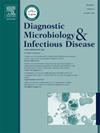喀麦隆西南部献血者、HIV患者和孕妇戊型肝炎病毒的流行、基因型分布和危险因素
IF 2.1
4区 医学
Q3 INFECTIOUS DISEASES
Diagnostic microbiology and infectious disease
Pub Date : 2025-02-13
DOI:10.1016/j.diagmicrobio.2025.116748
引用次数: 0
摘要
大多数HEV感染是自限性的,但妊娠晚期的孕妇和免疫功能低下的个体,如艾滋病毒感染者,面临包括致命性肝功能衰竭和慢性感染在内的风险。本研究调查了喀麦隆西南部监测有限的健康献血者和高危人群(如艾滋病毒患者和孕妇)的HEV患病率和基因型。在2023年3月至6月期间进行的一项横断面研究招募了712名参与者:289名献血者,233名艾滋病患者和190名孕妇。ELISA检测血清和粪便中抗HEV IgG和IgM抗体,巢式PCR检测ORF1和ORF2区HEV RNA。对HEV rna阳性样本进行测序,并确定基因型。在712名参与者中,7%的人检测出抗hev IgG阳性,2%检测出抗hev IgM阳性。献血者的抗hev IgG患病率最高(9%)。未发现HEV血清阳性与人口统计学或饮食危险因素之间存在显著关联。总体HEV RNA阳性率为1%,献血者(2%)和孕妇(1%)的阳性率最高,而HIV患者中未发现病例。系统发育分析显示,75%的HEV rna阳性样本属于基因型3a, 25%属于基因型3e。人类和猪HEV基因型3之间的核苷酸多样性表明,存在环境或其他间接传播途径,而不是猪到人的直接传播。这项研究强调了喀麦隆的戊型肝炎风险,特别是在献血者和孕妇中,强调了在hbv流行地区加强监测的必要性。本文章由计算机程序翻译,如有差异,请以英文原文为准。
Prevalence, genotype distribution, and risk factors of Hepatitis E virus in blood donors, HIV patients, and pregnant women in Southwest Cameroon
Most HEV infections are self-limiting, but pregnant women in their third trimester and immunocompromised individuals, such as those with HIV, face risks, including fatal liver failure and chronic infection. This study investigates HEV prevalence and genotypes in healthy blood donors and high-risk groups, such as HIV patients and pregnant women, in Southwest Cameroon, where surveillance is limited. A cross-sectional study conducted between March and June 2023 recruited 712 participants: 289 blood donors, 233 HIV patients, and 190 pregnant women. Serum and stool samples were tested for anti-HEV IgG and IgM antibodies using ELISA, and HEV RNA was detected by nested PCR targeting the ORF1 and ORF2 regions. HEV RNA-positive samples were sequenced, and genotypes identified. Among the 712 participants, 7 % tested positive for anti-HEV IgG and 2 % for anti-HEV IgM. Blood donors had the highest anti-HEV IgG prevalence (9 %). No significant associations were found between HEV seropositivity and demographic or dietary risk factors. The overall HEV RNA positivity rate was 1 %, with the highest rates in blood donors (2 %) and pregnant women (1 %), while no cases were found in HIV patients. Phylogenetic analysis revealed that 75 % of HEV RNA-positive samples belonged to genotype 3a, and 25 % to genotype 3e. The nucleotide diversity between human and pig HEV genotype 3 suggests the involvement of environmental or other indirect transmission routes, rather than direct pig-to-human transmission. This study highlights HEV risk in Cameroon, especially among blood donors and pregnant women, underscoring the need for enhanced surveillance in HBV-endemic regions.
求助全文
通过发布文献求助,成功后即可免费获取论文全文。
去求助
来源期刊
CiteScore
5.30
自引率
3.40%
发文量
149
审稿时长
56 days
期刊介绍:
Diagnostic Microbiology and Infectious Disease keeps you informed of the latest developments in clinical microbiology and the diagnosis and treatment of infectious diseases. Packed with rigorously peer-reviewed articles and studies in bacteriology, immunology, immunoserology, infectious diseases, mycology, parasitology, and virology, the journal examines new procedures, unusual cases, controversial issues, and important new literature. Diagnostic Microbiology and Infectious Disease distinguished independent editorial board, consisting of experts from many medical specialties, ensures you extensive and authoritative coverage.

 求助内容:
求助内容: 应助结果提醒方式:
应助结果提醒方式:


